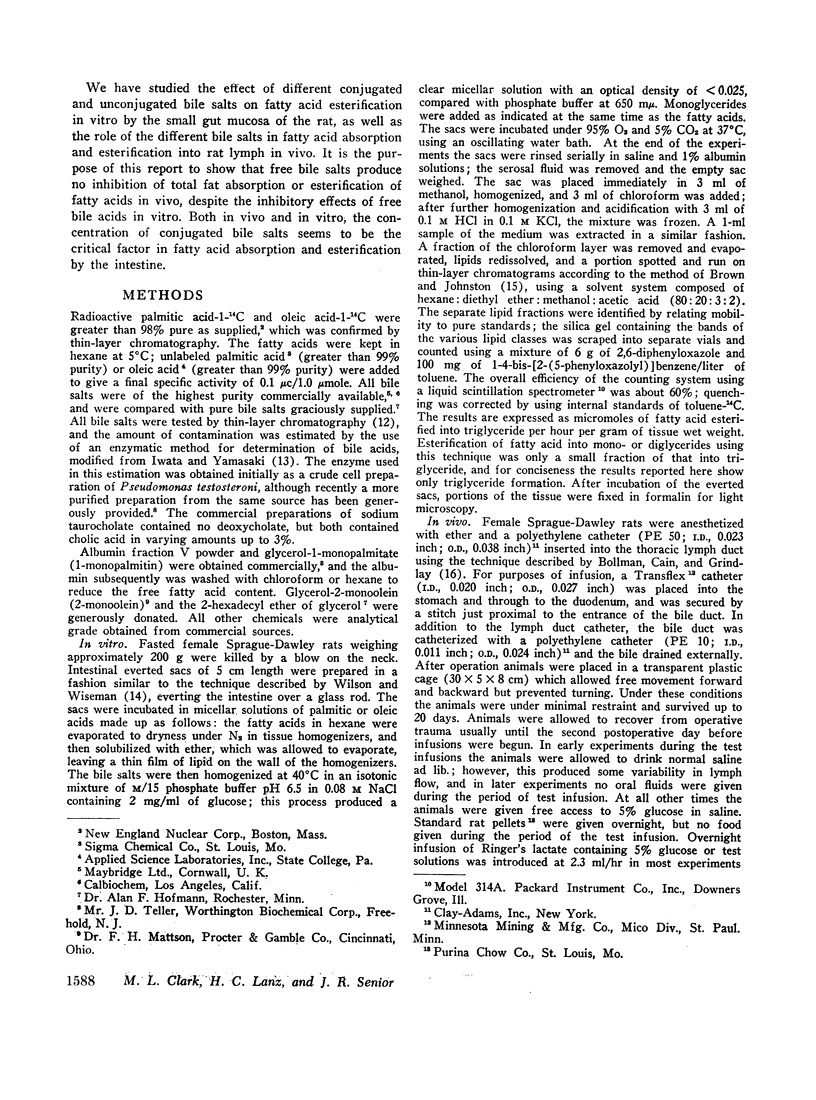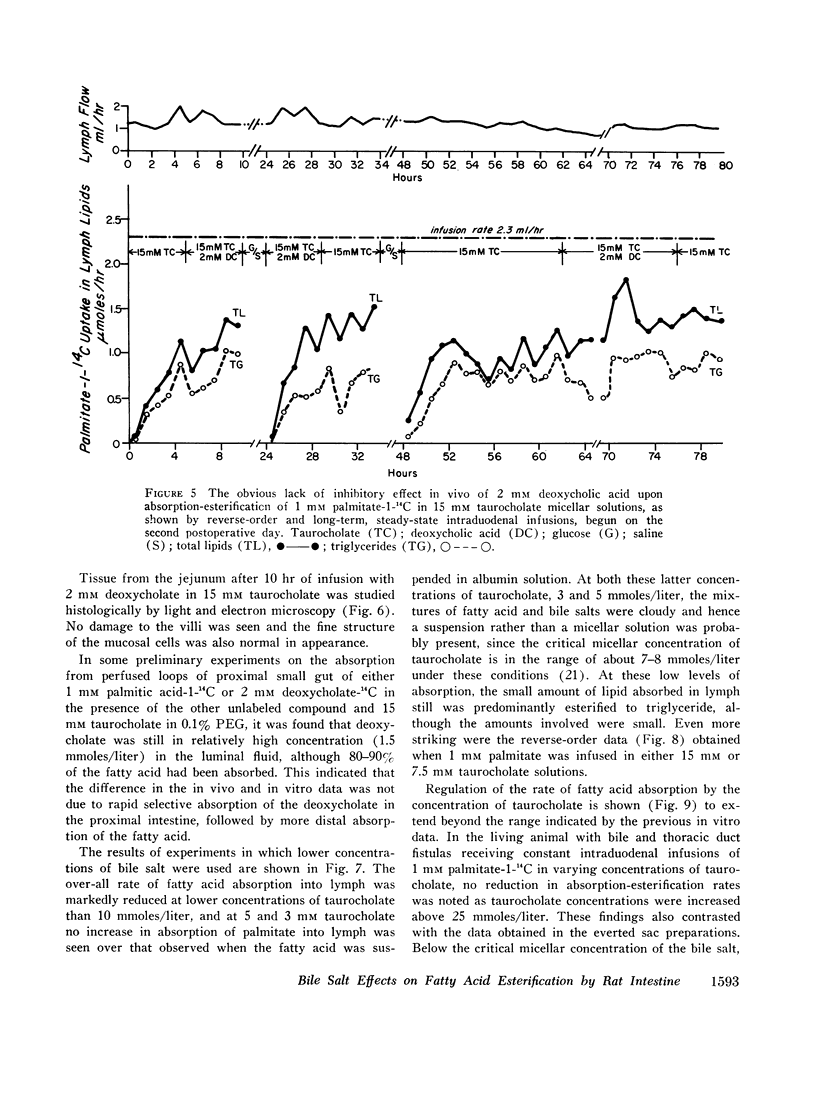Abstract
This study was performed to investigate whether the malabsorption of fat in the blind loop syndrome is due to the presence of free bile acids or to a deficiency of conjugated bile salts produced by bacterial degradation of normal bile salts, as well as to learn something of the mechanisms by which bile salts might regulate fat absorption. In the everted gut sac of the rat in vitro, conjugated bile salts were necessary for maximal rates of fatty acid esterification to triglycerides, whereas free bile acids inhibited this process even in the presence of physiologically normal or higher concentrations of conjugated bile salts. In contrast, in the living animal the addition of similar or higher concentrations of free bile acids to infusions of fatty acids in taurocholate micellar solutions produced no reduction in the amount of fatty acid absorbed into lymph or the amount of fatty acid esterified into lymph triglyceride. Both in vitro and in the living animal, reduction in the conjugated bile salt concentration reduced both the rate of fatty acid uptake by the intestine and the esterification into triglycerides. It is concluded that the steatorrhea of the blind loop syndrome or other conditions in which upper intestinal stasis allows bacterial proliferation is not due to presence of increased gut luminal concentrations of free bile acids, but rather is a consequence of lowered concentrations of conjugated bile salts.
Full text
PDF












Images in this article
Selected References
These references are in PubMed. This may not be the complete list of references from this article.
- DAWSON A. M., ISSELBACHER K. J. Studies on lipid metabolism in the small intestine with observations on the role of bile salts. J Clin Invest. 1960 May;39:730–740. doi: 10.1172/JCI104090. [DOI] [PMC free article] [PubMed] [Google Scholar]
- Dietschy J. M. Effects of bile salts on intermediate metabolism of the intestinal mucosa. Fed Proc. 1967 Nov-Dec;26(6):1589–1598. [PubMed] [Google Scholar]
- Dietschy J. M., Salomon H. S., Siperstein M. D. Bile acid metabolism. I. Studies on the mechanisms of intestinal transport. J Clin Invest. 1966 Jun;45(6):832–846. doi: 10.1172/JCI105399. [DOI] [PMC free article] [PubMed] [Google Scholar]
- Donaldson R. M., Jr Studies on the pathogenesis of steatorrhea in the blind loop syndrome. J Clin Invest. 1965 Nov;44(11):1815–1825. doi: 10.1172/JCI105289. [DOI] [PMC free article] [PubMed] [Google Scholar]
- Hill M. J., Drasar B. S. Degradation of bile salts by human intestinal bacteria. Gut. 1968 Feb;9(1):22–27. doi: 10.1136/gut.9.1.22. [DOI] [PMC free article] [PubMed] [Google Scholar]
- Hofmann A. F., Small D. M. Detergent properties of bile salts: correlation with physiological function. Annu Rev Med. 1967;18:333–376. doi: 10.1146/annurev.me.18.020167.002001. [DOI] [PubMed] [Google Scholar]
- IWATA T., YAMASAKI K. ENZYMATIC DETERMINATION AND THIN-LAYER CHROMATOGRAPHY OF BILE ACIDS IN BLOOD. J Biochem. 1964 Nov;56:424–431. doi: 10.1093/oxfordjournals.jbchem.a128013. [DOI] [PubMed] [Google Scholar]
- Kim Y. S., Spritz N., Blum M., Terz J., Sherlock P. The role of altered bile acid metabolism in the steatorrhea of experimental blind loop. J Clin Invest. 1966 Jun;45(6):956–962. doi: 10.1172/JCI105411. [DOI] [PMC free article] [PubMed] [Google Scholar]
- MORGAN R. G. THE EFFECT OF BILE SALTS ON THE LYMPHATIC ABSORPTION BY THE UNANAESTHETIZED RAT OF INTRADUODENALLY INFUSED LIPIDS. Q J Exp Physiol Cogn Med Sci. 1964 Oct;49:457–465. doi: 10.1113/expphysiol.1964.sp001751. [DOI] [PubMed] [Google Scholar]
- NORMAN A., GRUBB R. Hydrolysis of conjugated bile acids by Clostridia and enterococci; bile acids and steroids 25. Acta Pathol Microbiol Scand. 1955;36(6):537–547. doi: 10.1111/j.1699-0463.1955.tb04651.x. [DOI] [PubMed] [Google Scholar]
- Nair P. P., Gordon M., Gordon S., Reback J., Mendeloff A. I. The cleavage of bile acid conjugates by cell-free extracts from Clostridium perfringens. Life Sci. 1965 Oct;4(19):1887–1892. doi: 10.1016/0024-3205(65)90071-8. [DOI] [PubMed] [Google Scholar]
- PORTMAN O. W., SHAH S., ANTONIS A., JORGENSEN B. Alteration of bile salts by bacteria. Proc Soc Exp Biol Med. 1962 Apr;109:959–965. doi: 10.3181/00379727-109-27391. [DOI] [PubMed] [Google Scholar]
- Rosenberg I. H., Hardison W. G., Bull D. M. Abnormal bile-salt patterns and intestinal bacterial overgrowth associated with malabsorption. N Engl J Med. 1967 Jun 22;276(25):1391–1397. doi: 10.1056/NEJM196706222762501. [DOI] [PubMed] [Google Scholar]
- Simmonds W. J., Redgrave T. G., Willix R. L. Absorption of oleic and palmitic acids from emulsions and micellar solutions. J Clin Invest. 1968 May;47(5):1015–1025. doi: 10.1172/JCI105791. [DOI] [PMC free article] [PubMed] [Google Scholar]
- Tabaqchali S., Booth C. C. Jejunal bacteriology and bile-salt metabolism in patients with intestinal malabsorption. Lancet. 1966 Jul 2;2(7453):12–15. doi: 10.1016/s0140-6736(66)91744-2. [DOI] [PubMed] [Google Scholar]
- Tabaqchali S., Hatzioannou J., Booth C. C. Bile-salt deconjugation and steatorrhoea in patients with the stagnant-loop syndrome. Lancet. 1968 Jul 6;2(7558):12–16. doi: 10.1016/s0140-6736(68)92888-2. [DOI] [PubMed] [Google Scholar]
- WILSON T. H., WISEMAN G. The use of sacs of everted small intestine for the study of the transference of substances from the mucosal to the serosal surface. J Physiol. 1954 Jan;123(1):116–125. doi: 10.1113/jphysiol.1954.sp005036. [DOI] [PMC free article] [PubMed] [Google Scholar]



